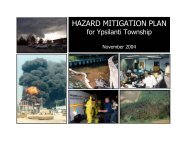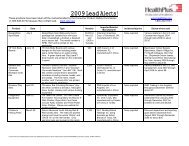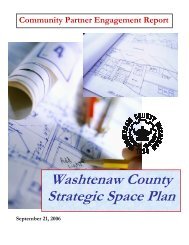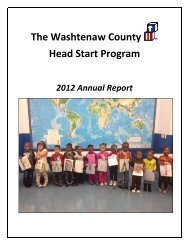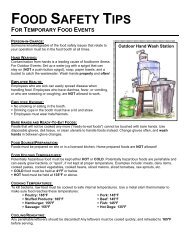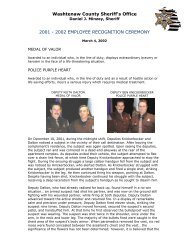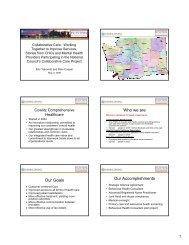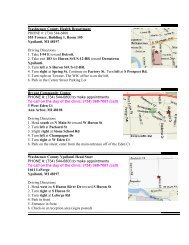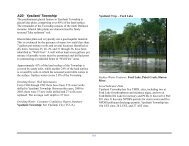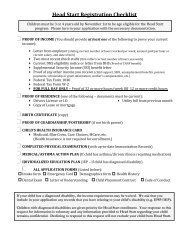Water Protection Activities in Washtenaw County
Water Protection Activities in Washtenaw County
Water Protection Activities in Washtenaw County
Create successful ePaper yourself
Turn your PDF publications into a flip-book with our unique Google optimized e-Paper software.
<strong>Water</strong>shed Plan BMP Title BMP Description BMP Outcome<br />
Mill Creek<br />
Mill Creek<br />
Mill Creek<br />
Mill Creek<br />
Implement native landscap<strong>in</strong>g<br />
ord<strong>in</strong>ance Encourage use of plants adapted to this geographic area Improved storm water <strong>in</strong>filtration , soil stabilization and habitat<br />
Native vegetation restoration<br />
program<br />
Identify and elim<strong>in</strong>ate illicit<br />
discharges<br />
Implement golf course nutrient<br />
management<br />
Mill Creek<br />
Implement phosphorus fertilizer<br />
reduction ord<strong>in</strong>ances Regulate selection, use, storage and disposal of fertilizers<br />
Require regular <strong>in</strong>spection, ma<strong>in</strong>tenance, and repair of<br />
Mill Creek Implement septic system ord<strong>in</strong>ances septic systems by ord<strong>in</strong>ance.<br />
Mill Creek<br />
Mill Creek<br />
Mill Creek<br />
Mill Creek<br />
Mill Creek<br />
Mill Creek<br />
Mill Creek<br />
Mill Creek<br />
Mill Creek<br />
Mill Creek<br />
Mill Creek<br />
Mill Creek<br />
Implement natural features<br />
ord<strong>in</strong>ances<br />
Utilize <strong>in</strong> stream habitat restoration<br />
techniques<br />
Construct and ma<strong>in</strong>ta<strong>in</strong> media/sand<br />
and organic filters<br />
Install and ma<strong>in</strong>ta<strong>in</strong> oil and grease<br />
traps<br />
Reduce directly connected<br />
impervious surface area<br />
Provide technical consultation and study, locate,<br />
coord<strong>in</strong>ate, and implement native landscap<strong>in</strong>g projects Reestablishes native species and restores riparian habitat<br />
Conduct storm water sampl<strong>in</strong>g program and <strong>in</strong>spections<br />
to trace illicit connections Identification of illicit discharge sources<br />
Practice turf management, wetland restoration,<br />
watercourse buffers and environmentally sensitive<br />
purchas<strong>in</strong>g and nutrient management - Certification is<br />
available through MSU Extensions Reduces negative effects of golf courses on local watersheds<br />
Protect local natural resources and direct development to<br />
suitable areas<br />
147<br />
Reduction of nutrients enter<strong>in</strong>g watershed reduc<strong>in</strong>g algal blooms and<br />
fish kills<br />
Prevents, detects, and controls spills, leaks, overflows, and seepage<br />
of septic systems<br />
Can be more protective than federal & state law to reflect local<br />
priority<br />
Create channel blocks, boulder clusters, covered logs,<br />
tree cover, bank cribs, and other restoration techniques Corrects and improves fish and wildlife deficiencies<br />
Construct variety of filters - usually two chambered sand<br />
or sand/peat mix Removes pollutants and particulates from storm water<br />
Install oil and grease traps for <strong>in</strong>dustrial, ma<strong>in</strong>tenance,<br />
vehicle wash<strong>in</strong>g, and restaurants<br />
Direct<strong>in</strong>g flows from roof dra<strong>in</strong>s and paved areas to<br />
stabilized vegetated areas<br />
Removes high concentration of petroleum products, grease, and grit,<br />
by gravity and coalesc<strong>in</strong>g plates<br />
Reduction <strong>in</strong> storm water peak discharges, run-off volume and<br />
erosion<br />
Construct and ma<strong>in</strong>ta<strong>in</strong> <strong>in</strong>filtration<br />
trenches Diverts storm water <strong>in</strong>to a trench with no outlet Stores storm water run-off and allows for soil <strong>in</strong>filtration<br />
Install and ma<strong>in</strong>ta<strong>in</strong> bioretention<br />
systems<br />
Landscap<strong>in</strong>g features <strong>in</strong> developed areas adapted to<br />
provide onsite treatment Sediment and nutrient filtration, slower runoff velocities<br />
Implement municipal well field<br />
protection Complete implementation of wellhead protections plans Protects dr<strong>in</strong>k<strong>in</strong>g water resources<br />
Monitor for water quality, quantity,<br />
biota<br />
Survey species of concern<br />
distribution and management<br />
Increase watershed education and<br />
ethic<br />
Implement a coord<strong>in</strong>ated<br />
<strong>in</strong>formation campaign<br />
Mill Creek Enhance site plan requirements<br />
Collect a consistent dataset of water quality parameters,<br />
biotic <strong>in</strong>dicators, and stream flow Establishes a basel<strong>in</strong>e for implement<strong>in</strong>g recommended BMPs<br />
Conduct study to exam<strong>in</strong>e condition of plant and animal<br />
species of concern like freshwater mussels<br />
Many activities <strong>in</strong>clude: Adopt-a-stream, school<br />
education, stewardship network<br />
Target nonpo<strong>in</strong>t source pollution prevention through<br />
traditional market<strong>in</strong>g methods<br />
Species can serve as bellwether for progress on watershed<br />
management<br />
Identifies responsible parties, promotes community ownership,<br />
identifies problems/solutions, <strong>in</strong>tegrates public feedback<br />
Prevents pollution from enter<strong>in</strong>g system by motivat<strong>in</strong>g behavioral<br />
modifications<br />
Review floodpla<strong>in</strong>, soil types, landmark trees,<br />
groundwater recharge areas, etc. Assures environmental responsible development



